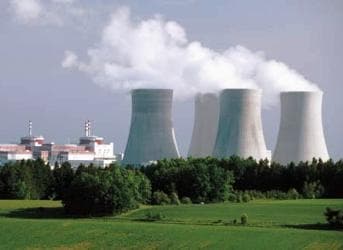One outgrowth of the U.S. super-secret WW2 Manhattan Project, which produced the nuclear bombs dropped on Hiroshima and Nagasaki, six years later, in 1951, a small experimental reactor in the United States produced the world’s first electricity generated by nuclear power. The first fully commercial nuclear power plant was constructed in the U.S. Dresden Unit 1 in Illinois had a capacity of 250 megawatts and came online in 1960 and operated until 1978. In 1962 Canada became the second country to generate electricity from nuclear power. Canada's first nuclear power plant, called NPD for Nuclear Power Demonstration, generated as modest 20 megawatts. As of October 2012, about 15.2 percent of Canada's electricity is now produced by nuclear power.
Sixty-two years after America’s first civilian reactor proved the feasibility of generating electricity from nuclear power, the U.S. government’s Energy Information Agency reports that 31 countries now have nuclear power programs, generating more than 370 gigawatts worldwide. The report notes, “From the early 1970s to the early 1990s, nuclear power steadily grew around the world, with brief periods of relatively slow growth following the accidents at Three Mile Island (1979) and Chernobyl (1986), as the nuclear industry absorbed the lessons learned from both incidents.”
Related article: California’s Nuclear Headache is Only Just Beginning
As for Fukushima, the report continues, “With the exception of the developing economies in Asia, nuclear power capacity remained relatively stable between the mid-1980s until the accident at the Fukushima Daiichi reactor in March of 2011."
Following the accident at Fukushima, nuclear industry reactions to the accident varied widely. Italy canceled its plans to build new nuclear power plants. Germany announced the shutdown of all nuclear power plants by 2022. China—where plans for large increases in nuclear capacity had been announced—instituted a temporary moratorium on new approvals for nuclear power construction that lasted 20 months before it was lifted at the end of October 2012.”
Despite Fukushima, global growth in nuclear power is destined to continue, with 69 nuclear power reactors currently under construction around the world, particularly in hydrocarbon poor Asia, where power demand continues to surge. While among Asian nations, Japan in the 1960s was the first to adopt nuclear power, between 1980 and 2012, nuclear capacity in Asia rose nearly 250 percent, led primarily by South Korea, Japan, and India, with China over the past decade also embracing nuclear power.
This is a trend that the EIA forecasts will continue. The EIA, in its “International Energy Outlook 2013 (IEO2013),” projects that “world energy consumption will grow by 56 percent between 2010 and 2040.”
Where will that growth occur? According to the EIA, “Much of the growth in energy consumption occurs in countries outside the Organization for Economic Cooperation and Development (OECD), known as non-OECD, where demand is driven by strong, long-term economic growth. Energy use in non-OECD countries increases by 90 percent; in OECD countries, the increase is 17 percent.”
But in Britain and Canada, two of the oldest civilian nuclear power producers the situation is more nuanced.
In Canada, on 10 October Ontario's Liberal government abandoned plans to spend billions of dollars to build two new nuclear reactors first planned in 2009 at a projected cost of $26 billion, saying that the province doesn't need the power to meet its electricity demand. In announcing the decision Energy Minister Bob Chiarelli told reporters, "New nuclear will not be part of the long-term energy plan which we hope to finalize before the end of this year. We're in a comfortable surplus position at this point in time, and it's not advisable to make the major investments in new nuclear. The costs have come down, but they have not come down enough to justify us building new nuclear when we have a very comfortable surplus."
Britain is in a different situation, where its cash-strapped nuclear power industry is soliciting outside investment even from China. China already has 17 nuclear reactors and another 28 plants under construction.
Related article: How Our Inability to Calculate Risk Opened the Doors for Fukushima
On British Chancellor George Osborne’s current trip to China, he told the biggest Chinese nuclear companies that in the future they will even be able to own controlling stakes in British power stations, and not just small minority shares, up to 100 percent.
Which raises the question – why?
ADVERTISEMENT
Simple economics – British investors have shied away from financing new British nuclear power plants because of their enormous cost, a problem compounded by Whitehall’s refusal to finance these expensive projects directly, even though it dangled the carrot of allowing the owners of any new nuclear generators to charge well above the current market price for any power they produce in years and decades to come in order to recoup their billions in development and construction costs. No such problem exists with the affluent Chinese, although nationalist grumblings have already begun.
So, nuclear power’s future lies increasingly in Asia, and perhaps its financing of Western nuclear power plants as well."
By. John C.K. Daly of Oilprice.com


















